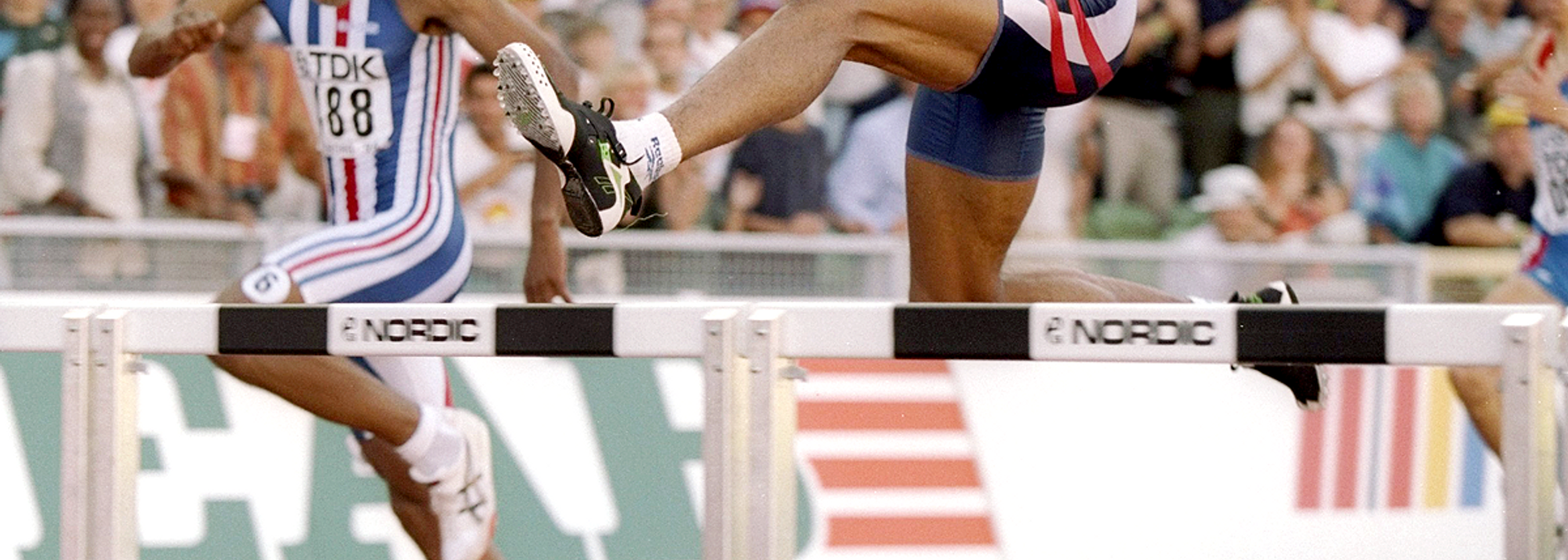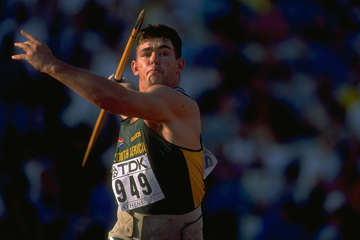Derrick Adkins on his way to winning the 400m hurdles at the 1995 IAAF World Championships (© Getty Images)
For three glorious years in the mid-1990s, Derrick Adkins reigned supreme in the men’s 400m hurdles. From 1994 to 1996 the US athlete was ‘the man’ in his event, winning world and Olympic titles and bettering 48 seconds a total of 21 times
As one of only four men in history to concurrently hold both the world and Olympic titles – alongside Ed Moses, Kevin Young and Felix Sanchez – Adkins should quite rightly be regarded as one of the finest ever exponents of a discipline that some refer to as the ‘man killer’.
Born in Brooklyn but raised in Long Island, Adkins was first exposed to athletics from the age of seven via the Lakeview Speedsters, a club his father helped set up as a local community sports project.
A huge fan of the sport from the beginning, it was not, however, until he underwent a dramatic growth spurt – growing 20 centimetres in two years – did he start to excel.
The late developer ran a high school national lead time aged 17 before later moving on to Georgia Tech, where under the guidance of his first college coach, Buddy Fowlkes, he lowered his PB to a slick 48.60.
In his final year at college he qualified for the USA team to compete at the 1991 IAAF World Championships in Tokyo, placing sixth in the final in 49.28 behind Zambian Samuel Matete.
“I was aged 21 at the time, the youngest on the team alongside Quincy Watts (the 1992 Olympic 400m champion),” said Adkins, who during his professional career continued to be coached by Grover Hinsdale, his second college coach. “I was just happy to be on the same team as the likes of Renaldo Nehemiah and Carl Lewis, people I really looked up to. I was happy to take sixth.”
The following year Adkins finished fourth at the US Olympic Trials to just miss out on making the team for the Olympic Games in Barcelona. Further disappointment was to follow at the 1993 IAAF World Championship in Stuttgart when he wound up seventh in the final behind world record-holder and compatriot Kevin Young.
“I considered seventh like going backwards,” he says. “I wanted a better place.
Yet if Adkins wanted better, his prayers were answered in 1994 when he made a giant leap forward.
From a previous best of 48.39, he lowered his PB to a world-leading 47.70 and smashed through the 48-second barrier on eight occasions. He claimed the US title, won a string of leading European one-day meetings and struck gold at the Goodwill Games in St Petersburg.
The New Yorker is at a loss to explain why he emerged as a world-class performer in 1994.
“I was doing the same things with my coach as I had while a Georgia Tech student, although maybe because I was now no longer at college (and no longer had the distractions of studying) the training really started to pay off,” he explains. “I found myself running faster in May of that year and by July I felt myself running faster at the meets.”
In 1995 he emerged even stronger, winning eight of nine 400m hurdles finals, including a successful defence of his US title leading into the IAAF World Championships in Gothenburg. But Adkins knew he faced a huge challenge to win gold in the Ullevi Stadium after a lifetime best of 47.54 was good enough for just second place behind French hurdler Stephane Diagana in Lausanne, just one month before the World Championships.
“That day he (Diagana) surprised everyone because for much of that season it was been between me and Samuel Matete, but out of the blue he ran 47.37,” he explains. “That left me worried going into the World Championships. I wondered if he was going to run that fast again.
Sharing a room in Gothenburg with 400m sprinter Derek Mills – who would go on to win 4x400m gold – Adkins progressed impressively through the rounds and gained a psychological edge on his rivals by qualifying fastest for the final and beating Diagana by 0.12 with a 48.25 clocking in his semi-final.
In the final he adopted his trademark tactic.
“Most of the time I used to run my races by going out quickly over the first 200m,” he explains. “Sometimes the opposition would catch me and sometimes they wouldn’t. I remember that race was difficult for me. It was a little cold, about 50F (10C) with a headwind on the back stretch, which made me tired early. Sometimes even when you win a race, you struggle. This was the case in Sweden. Over the last two hurdles, I hoped I wouldn’t be passed because I didn’t have anything left.
“I was aware of both Samuel and Stephane coming. I just had to focus on my technique because I had no more gas left. All I could focus on was running at the proper angle.”
Despite the increasingly ominous presence of 1991 world champion Matete, Adkins held on by 0.05 to strike gold in 47.98 with Diagana taking bronze in 48.14.
“Winning that world title gave me the confidence to win in Atlanta (at the 1996 Olympics),” he says. “As a track athlete, I consider the World Championship gold just as significant as my Olympic gold because (just like at the Olympic Games) I had proved I was the best in the world.
At the 1996 Atlanta Olympics, Adkins was once again imperious, striking gold by a decisive margin of 0.24 from Matete and equalling his lifetime best of 47.54.
Unfortunately, bouts of chronic depression meant he never again came close to repeating his glory years of 1994-1996. He retired from the sport in 2002 aged 32.
“I had suffered depression since I was young,” explains Adkins. “In ’94, ‘95 and ’96, I would be low, then after winning a big race in Europe I’d be happy for a few days before crashing. I’d then train hard and get my mind psyched up for another race. From 1997 I ran with medication because I felt I needed it for my health, although it sedated me and I lost a lot of my sprint ability.”
Following retirement, Adkins – who had been teetotal during his track career – started drinking regularly as a means of coping with his depression and for a decade struggled with alcohol-related issues.
He describes this 10-year period in his life as “a tough time” but his strong belief in God has helped steer him in the right direction and away from his reliance on alcohol.
“I’ve had a lot of downturns since winning those two golds (World Championship and Olympics). I’ve seen psychiatrists and been to AA (Alcoholics Anonymous) and my faith has helped me more than anything,” he says. “I’m now in complete control of my depression. I have ups and downs like anyone else, but whereas years ago my depression was very chronic, I don’t need medicine today.”
Despite his issues, from 2006 he spent five years as director of track and field and educational development at the Armory, where he helped convince Norbert Sander to move the historic Millrose Games from Madison Square Garden to the Armory.
In 2011 he took up a role as an outreach representative for the New York Road Runners. Although he still carries out some part-time work for the NYRR, his full-time position today is an admissions recruiter for Nyack College, a Christian college in New York.
“I like the fact I am doing something different away from sports,” says Adkins, who still runs every other day.
The 46-year-old – who now lives back in Lakeview, Long Island, where he was raised – is proud of winning his personal battles but also still gains immense satisfaction from his golden track career.
“I know the past couple of Olympic titles (won by Kerron Clement and Felix Sanchez) were slower than my Olympic titles,” he says before adding with a laugh: “I know it is not a competition, but I’m glad my time is faster than theirs.”
Steve Landells for the IAAF





